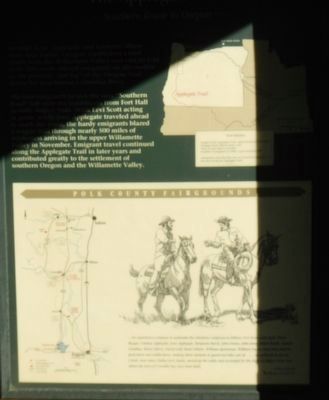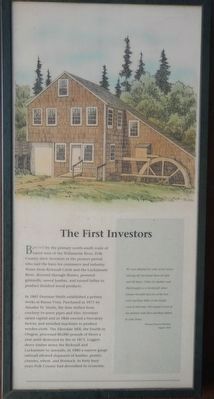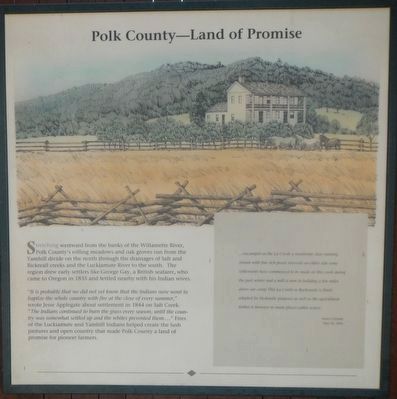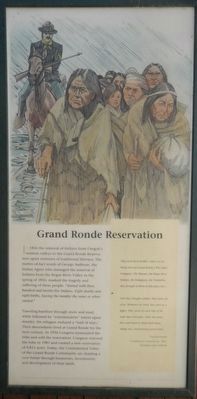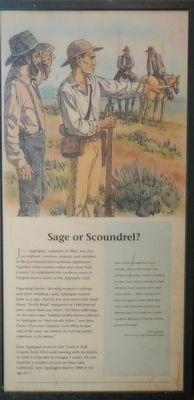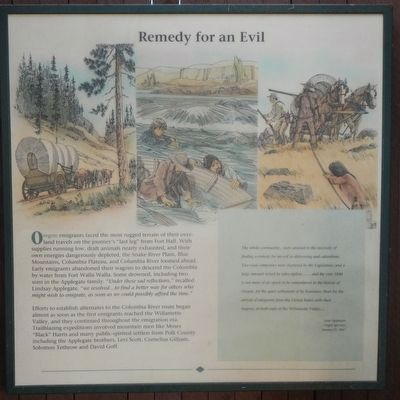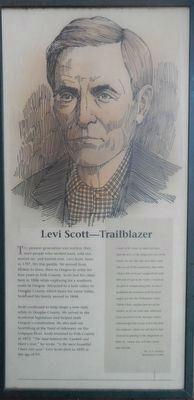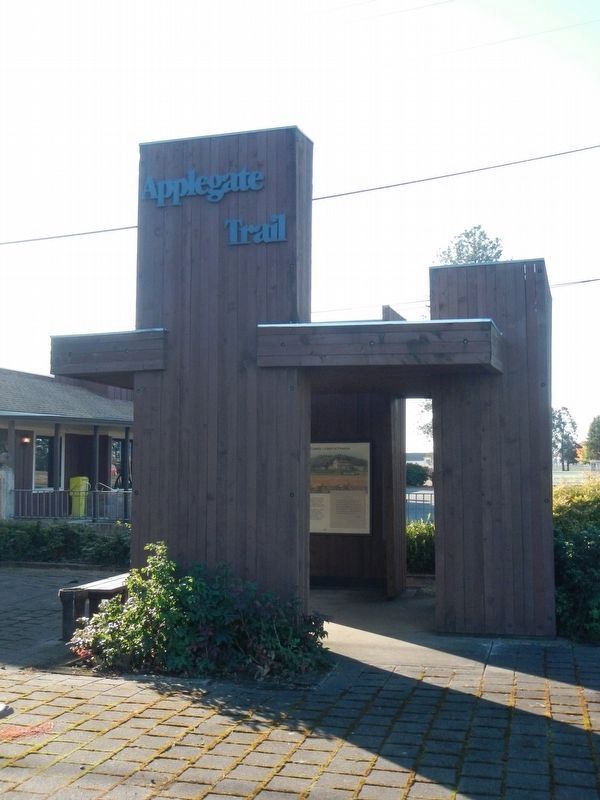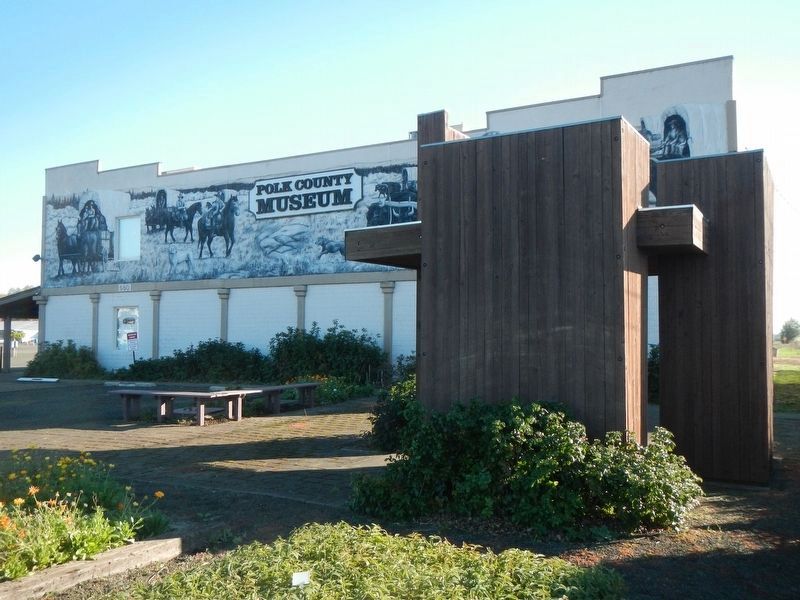Rickreall in Polk County, Oregon — The American West (Northwest)
Polk County Fairgrounds Applegate Trail Kiosk
Southern Route to Oregon
Inscription.
(Seven panels dealing with topics related to the Applegate Trail are found at this kiosk:)
In 1846, Jesse Applegate and fourteen others from near Dallas, Oregon, established a trail south from the Willamette Valley and east to Fort Hall. This route offered emigrants an alternative to the perilous "last leg" of the Oregon Trail down the treacherous Columbia River.
The first emigrants to trek the new "Southern Road" left with the trailblazers from Fort Hall in early August 1846. With Levi Scott acting as guide, while Jesse Applegate traveled ahead to mark the route, the hardy emigrants blazed a wagon trail through nearly 500 miles of wilderness arriving in the upper Willamette Valley in November. Emigrant travel continued along the Applegate Trail in later years and contributed greatly to the settlement of southern Oregon and the Willamette Valley.
...we organized a company to undertake the enterprise composed as follows: Levi Scott, John Scott, Henry Boyus, Lindsay Applegate, Jesse Applegate, Benjamin Burch, John Owens, John Jones, Robert Smith, Samuel Goodhue, Moses Harris, David Goff, Benit Osborn. William Sportsman, William Parker. Each man had his pack-horse and saddle-horse, making thirty animals to guard and take care of. ......we gathered on the La Creole, near where Dallas now stands, moved up the valley and encamped for the night on Mary's River, near where the town of Corvallis has since been built. -- Lindsay Applegate
Bisected by the primary north-south route of travel west of the Willamette River, Polk County drew investors in the pioneer period who laid the basis for commerce and industry. Water from Rickreall Creek and the Luckiamute River, diverted through flumes, powered gristmills, sawed lumber, and turned lathes to produce finished wood products.
In 1865 Freeman Smith established a pottery works at Buena Vista. Purchased in 1871 by Amadee M. Smith, the firm shifted from crockery to sewer pipes and tiles. Investors raised capital and in 1866 erected a two-story factory and installed machines to produce woolen cloth. The Ellendale Mill, the fourth in Oregon, processed 80,000 pounds of fleece a year until destroyed by fire in 1871. Loggers drove timber down the Rickreall and Luckiamute to sawmills. In 1880 a narrow gauge railroad allowed shipments of lumber, prunes, cherries, wheat, and livestock. In forty busy years Polk County had diversified its economy.
We were detained by some of our horses straying off, but found them all right and left King's Valley by another road that brought us to Rickr(e)all where Senator Nesmith had one of the best Grist and flour Mills on the Pacific coast at that time. We loaded several of our animals with flour and then started to come home. -- Herman Francis Reinhart, August 1852
Stretching westward from the banks of the Willamette River, Polk County's rolling meadows and oak groves run from the Yamhill divide on the north through the drainages of Salt and Rickreall creeks and the Luckiamute River to the south. The region drew early settlers like George Gay, a British seafarer, who came to Oregon in 1853 and settled nearby with his Indian wives.
"It is probable that we did not yet know that the Indians were wont to baptize the whole country with fire at the close of every summer," wrote Jesse Applegate about settlement in 1844 on Salt Creek. "The Indians continued to burn the grass every season, until the country was somewhat settled up and the whites prevented them...." Fires of the Luchiamute and Yamhill Indians helped create the lush pastures and open country that made Polk County a land of promise for pioneer farmers.
...encamped on the La Creole a handsome clear running steam with fine rich prairie intervals on either side some settlements have commenced to be made on this creek during the past winter and a mill is now in building a few miles above our camp This La Creole or Rockreaole is finely adapted for Hydraulic purposes as well as the agricultural timber is however in many paces rather scarce. -- James Cayman, May 26, 1845
In 1855 the removal of Indians from Oregon's western valleys to the Grand Ronde Reservation upset centuries of traditional lifeways. The mater-of-fact words of George Ambrose, the Indian Agent who managed the removal of Indians from the Rogue River Valley in the spring of 1856, masked the tragedy and suffering of these people: "Started with three hundred and twenty-five Indians. Eight deaths and eight births, leaving the number the same as when started."
Traveling barefoot through snow and mud, while followed by "exterminators" intent upon murder, the refugees endured a "trail of tears." Their descendants lived at Grand Ronde for the next century. In 1956 Congress terminated the tribe and sold the reservation. Congress restored the tribe in 1983 and created a new reservation of 9,811 acres. Today, the Confederated Tribes of the Grand Ronde Community are charting a new future through businesses, investments, and development of their lands.
They took them farther, where we are living now (at Grand Ronde.) The Upper Umpquas, the Shastas, the Rogue River Indians, the Kalapuyas, the Yonkallas, they brought of them to this place here.
Now they brought soldiers, they took care of us. Whenever we went, they gave us a paper. They stood on each side of the road, they held guns. Some ran away, they went back to where their home village was. Such persons got no land. -- Victoria Howard, "Conditions at Grand Ronde, 1859" "Clackamas Texts (1958-59)
Jesse Applegate, a pioneer of 1843, was also an explorer, surveyor, essayist, and member of the provisional and territorial legislatures. Together with fourteen other men from Polk County, he established the southern route to Oregon known today as the Applegate Trail.
Opposing slavery, favoring women's suffrage, and often wielding a pen, Applegate earned fame as a sage - but he was not universally liked. Many "South Road" emigrants of 1846 blamed him - more than any other - for their sufferings on the new route. Tabitha Moffet Brown referred to Applegate as "that rascally fellow," and Jesse Quinn Thornton claimed "every thing he had said of the road - we learned, by sad and painful experience, to be untrue."
Jesse Applegate lived on Salt Creek in Polk County from 1843 until moving with his family in 1849 to Yoncalla in Douglas County. He also lived for a number of years at Clear Lake, California. Jesse Applegate died in 1888 at the age of 77.
Some call me an impractical and a visionary. They greatly mistake. I am practical in all things, visionary in nothing. It is true I have erected a standard of right and wrong in my conscience from which I never swerve.... While I am always in earnest in support of what I think right, I strive to be always fair and just to my opponents and I never suffer my religious or political differences to interfere with my personal friendships. -- Jesse Applegate, Letter to Capt. John Ainsworth (1860)
Oregon emigrants faced the most rugged terrain of their overland travels on the journey's "last leg" from Fort Hall. With supplies running low, draft animals nearly exhausted, and their own energies dangerously depleted, the Snake River Plain, Blue Mountains, Columbia Plateau, and Columbia River loomed ahead. Early emigrants abandoned their wagons to descend the Columbia by water from Fort Walla Walla. Some drowned, including two sons in the Applegate family. "Under these sad reflections," recalled Lindsay Applegate, "we resolved...to find a better way for others who might wish to emigrate, as soon as we could possible afford the time."
Efforts to establish alternates to the Columbia River route began almost as soon as the first emigrants reached the Willamette Valley, and they continued throughout the emigration era. Trailblazing expeditions involved mountain men like Moses "Black" Harris and many public-spirited settlers from Polk County including the Applegate brothers, Levi Scott, Cornelius Gilliam, Solomon Tethrow and David Goff.
The whole community...were aroused to the necessity of finding a remedy for an evil so distressing and calamitous. Two road companies were chartered by the Legislature, and a large amount raised by subscription.... ...and the year 1846 is not more of an epoch to be remembered in the history of Oregon, for a quiet settlement of its boundary, than for the arrival of emigrants from the United States with their wagons, at both ends of the Willamette Valley. -- Jesse Applegate, Oregon Spectator, January 21, 1847.
The pioneer generation was restless; they were people who worked hard, sold out, moved on, and started over. Levi Scott, born in 1797, fits this profile. He move from Illinois to Iowa, then to Oregon to settle for four years in Polk County. Scott lost his claim here in 1846 while exploring for a southern route to Oregon. Attracted to a lush valley in Douglas County which bears his name today, Scott and his family moved in 1848.
Scot continued to help shape a new state while in Douglas County. He served in the territorial legislature and helped draft Oregon's constitution. He also laid out Scottsburg at the head of tidewater on the Umpqua River. Scott returned to Polk County in 1872. "The land between the Yamhill and Mary's river," he wrote, "is the most beautiful I have ever seen." Levi Scott died in 1890 at the age of 93.
I said to Mr. Scott, he must not leave, that the lives of the emigration was in his hands, he was the only man that could take us out of the mountains, that while I had a bite of bread I would divide with him and if I got to the Valley I would do my part in remunerating him. So like a gentleman he remained until the front wagon got into the Willamette Valley. I think I fully satisfied him for all his trouble, as for me some time afterward I saw an article in the Spectator which acknowledged the receipt of $21.00 from one emigrant, which was all that he had received for piloting in the emigration of forty-six. I knew very well that I paid that $21.00. -- Rev. A.E. Garrison, Recollection of 1846
Erected by Applegate Trail Coalition.
Topics and series. This historical marker is listed in these topic lists: Roads & Vehicles • Settlements & Settlers. In addition, it is included in the Applegate Trail series list.
Location.
44° 55.436′ N, 123° 13.675′ W. Marker is in Rickreall, Oregon, in Polk County. Marker is on South Pacific Highway West (Oregon Route 99W) near Bursh Grove Lane, on the right when traveling north. Touch for map. Marker is at or near this postal address: 670 South Pacific Highway West, Rickreall OR 97371, United States of America. Touch for directions.
Other nearby markers. At least 8 other markers are within 10 miles of this marker, measured as the crow flies. James W. Nesmith (approx. 0.2 miles away); Welcome to Dallas (approx. 4.4 miles away); T.G. Bligh Building (approx. 9.4 miles away); Salem (approx. 9˝ miles away); Dedicated to You, A Free Citizen in a Free Land (approx. 9.7 miles away); Marking an Old Trail (approx. 9.7 miles away); Willamette University College of Medicine (approx. 9.7 miles away); Giant Sequoia (approx. 9.8 miles away).
More about this marker. The kiosk is located in front of the Polk County Museum.
Also see . . . Hard times befall trail kiosk -- Polk County Itemizer-Observer. What happens with good ideas that lack funding?
If they look like the Applegate Trail kiosk on the west side of the Polk County Museum in Rickreall, they grow weeds and their roofs fall in. (Submitted on March 1, 2018, by Barry Swackhamer of Brentwood, California.)
Credits. This page was last revised on March 1, 2018. It was originally submitted on February 24, 2018, by Barry Swackhamer of Brentwood, California. This page has been viewed 364 times since then and 30 times this year. Photos: 1, 2, 3, 4, 5, 6, 7, 8, 9. submitted on February 24, 2018, by Barry Swackhamer of Brentwood, California.
